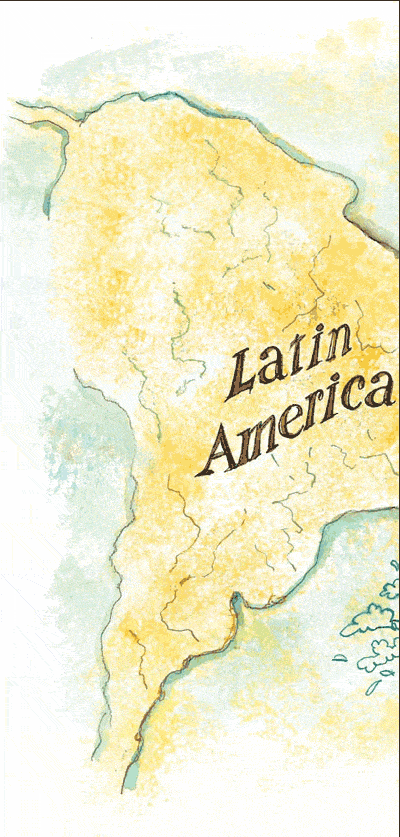Spains banking titans have placed a $26 billion bet on Latin America becoming their growth engine of the future. It looks like 2004 could be the make-or-break year for that gamble.

With domestic retail banking reaching the saturation point and cross-border mergers in Europe looking ever less likely, the logical area of growth for Spains two big banks, Banco Bilbao Vizcaya Argentaria (BBVA) and Grupo Santander, is Latin America.As one Santander executive remarks,I feel perfectly comfortable sending 20 people to do a due diligence on a Latin American bank.We speak the same language, and we understand their culture. I cannot say the same about Morocco or Indonesia, for instance.
Santanders and BBVAs investment in Latin America, in terms of GNP scale, represents the biggest transfer of currency across the Atlantic since Spanish galleons crossed the other way laden with treasure from the New World. Some critics argue that the banks have committed too heavy an investment outside the developed world, in an area where the security of their equity may be at risk.The Spanish have this persistent feeling that Latin America is their bailiwick, but these banks cannot control the local economies and currency fluctuations, says Norman Bernard, director of London-based banking consultancy First Consulting.They dont know whats going to come next that could destabilize the local currencies, and once theyre in trouble there is no way they can IPO those banks or find buyers to take on anything big enough to make a serious dent in their exposure. It doesnt make sense to have this much of your equity invested in soft currencies, he argues.
Santanders chairman, Emilio Botn, who has built up a $16 billion Latin American franchise over the past decade, sees things very differently. Botn stated his position on the region in no uncertain terms when announcing the groups results in late January. Latin America is part of Santanders DNA, he said.Without it we would not be what we are today.That was a bold claim: Santander is Spains largest bank and one of the top five in Europe by market capitalization. Botn continued: We have only two options in the region: to grow, or to grow.
Botn underscored his commitment t o L a t i n America by rejecting the temptation to embark on a buying spree in Europe, which some other banks see as the way forward in their mature domestic markets. Santanders 2003 performance topped analysts forecasts, with net profits up 16.2% to a record 2.611 billion. Retail banking provided 84% of group profits, of which 32% came from Latin America and the rest from Spain and European operations.
When presenting the banks results, Botn assured his shareholders that the worst is over and the best is yet to come in Latin America. On the face of it, last year was not an encouraging period for Santanders Latin American businesses. Net profits from the region tumbled to 1.32 billion, a 4.65% decline compared with the previous year. Merrill Lynch Spanish banks analyst Antonio Ramrez explains that this was largely the impact of currency fluctuations.Santander and BBVA had to absorb the big impact of lower valuation of local currencies and the decline of the dollar against the euro, he says. In Santanders case, the bank achieved earnings growth of 28% in local currency terms.
Spanish Bulls Tough it Out

BBVA turned in a creditable performance last year, with net profit at group level up 29.5%, to 2.227 bilfully from the expected profit growth of its Mexican subsidiary in the coming years, said S&P;s analyst Jess Martnez. After restructuring, operating profits from Bancomer will be driven by an improving business mix, a more efficient fee structure, and tight cost controls. Mexico is a market with economic and industry risks that are still relatively high compared with those of developed markets, but its economy and banking industry are improving and its vulnerability to external shocks is gradually being reduced.
BBVAs chairman, Francisco Gonzlez, remains confident that despite a history of economic and political turbulence, Latin America is this year on track to deliver good value. Growth in Latin America will in 2004 be close to the regions potential, hovering between 3.5% and 4%, he told a group of investors in Latibex, the Madrid stock exchanges Latin American index. Latin America is in a good position to exploit the international economic recovery and attract more capital.BBVA recently re-affirmed its commitment through DBVA, a strategic partnership with Darby Overseas Investments, chaired by former US Treasury secretary Nicholas Brady. The private equity fund was set up to acquire shareholdings in selected Latin American enterprises.
All eyes are on the much-touted Latin American recovery in 2004, which to a considerable extent will determine the sustainability of profit growth at Santander and BBVA. Enrique Daz-Barcel, banking analyst at BNP Paribas, cautions that it is difficult to talk about transition periods in Latin America because of the regions historical volatility.But 2004 looks like a better year for the major countries when you consider the macroeconomic estimates, he says. This should translate into better earnings for Santander and BBVA, although there may be a lag. Last year saw a reduction in country risk rates that, according to Daz-Barcel, means Latin America is starting to become a developed area.But volatility will come back, and country risk rates will go up again at some point, he says.
Merrills Ramrez believes that Latin Americas economic recovery will improve the environment for banking, with lending, lower provisions and better margins coming through as interest rates rise in most countries except Brazil. In that country,however, lower reserve requirements, expanding consumer credit and shrinking provisions should offset margin pressure from lower rates.
The outlook is for high twodigit earnings growth in local currency for BBVA and Santander, Ramrez says.The main concern is further currency depreciation if the dollar weakens. Of the two banks, Ramrez views Santander as the more geared to recovery,with its larger and more diversified franchise.BBVA has cut risk exposure in Brazil, despite it being an attractive and large market, he notes.
The strategies of the two big Spanish banks have gone through several metamorphoses since they began piling into the region in the early 1990s.While both are chasing the same business, the two banksapproaches have varied widely in terms of greenfield operations versus local partnerships, minority versus majority stakes and the type of economies where each is trying to establish a foothold.
At the outset Santander was keen to take full ownership of its Latin American subsidiaries, giving it control over the local business strategy as well as management. BBVA, on the other hand, preferred the minority-stake approach, arguing that this mitigated the extent of damage in the event of a meltdown. Strict adherence to this strategy has been largely abandoned over the years. Santander achieves higher earnings than BBVA, but it has also invested more in the region. Santander is focusing on the Brazilian market, where it has acquired three banks. BBVA exited Brazil last year, but it is well established in Mexico, a country with a big weighting on a regional basis. Brazil accounts for about half of Santander’s total Latin American earnings, while BBVA derives some 60% of its regional earnings from Mexico.
The Convergence Play
The two Spanish banks are counting on a convergence of the Latin American economies to a more developed state, says Ramrez. This will enable them to expand their financial services business and offer more private pension plans, mutual funds and other products. There is a huge potential for longer-term growth with a commensurate decline in the risk profile that will translate into a higher value of their earnings, he adds. This is already happening in Chile, while Mexico and Brazil are heading in a similar direction and should, according to Ramrez, develop stronger and more developed economies.
This is not the first time that Latin America has been viewed as a kind of promised land. Unfortunately, that promise keeps being broken by either political or financial crises.The Spanish banks are hoping that this time will be different. Most of the region is showing growth on the back of recovery in the US and Asia, and Latin America stands to benefit from higher prices for raw materials. Rates and risk aversion are on the decline, and the regions economies can reasonably be expected to perform better this year.
JPMorgan analyst Carla Atunes da Silva believes that 2003 was the year of stabilization in Latin America but that credit growth opportunities have not yet delivered their full potential.We have increased our estimates in Latin America by 2% in 2004 and 10% in 2005, which should translate into higher earnings multiples, particularly into 2005, she says.Despite being impacted by the weakness in currency, Latin American earnings have started to show timid signs of the times to come.
Jules Stewart



